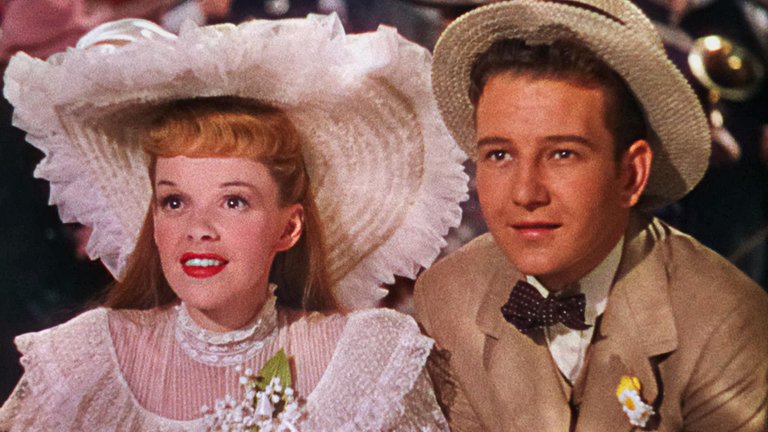Film Review: Meet Me in St. Louis (1944)

Metro Goldwyn-Meyer is seen as the greatest of all Classic Hollywood studios. Much of this reputation have been built on the musicals, especially those made in the latter stages of the era, when the colour cinematography was becoming the norm for such content. One of the earliest examples of the trend is Meet Me in St. Louis, 1944 film directed by Vincente Minelli, which became one of the most popular films of its time.
The film is based on 1942 novel by Sally Benson, inspired by author’s early years in St. Louis four decades ago. The plot begins in 1903, in a year before 1904 St. Louis World’s Fair. While most of her fellow citizens of St. Louis are getting excited over the event, Esther Smith (played by Judy Garland), 17-year girl from upper middle class family, has fallen in love with her young neighbour John Truett (played by Tom Drake). Her older sister Rose (played by Louise Bremmer) awaits to be receive marriage proposal by telephone call from Warren Sheffield (played by Robert Sully). Idyllic life of Smiths, however, might end when the Judy’s father and family patriarch Alonzo Smith (played by Leon Ames) receives offer to transfer to better-paid job in New York City. He accepts and that means that his family would have to accompany him. For Esther that could mean the end of romance with John, while her mother and siblings are about the miss the wonders of World’s Fair.
Meet Me in St. Louis was made during Second World War and for American audiences, faced with military draft, rationing and other deprivations, it provided excellent escape into world that was both different and familiar. Producer Arthur Freed has found perfect setting in 1900s, showing America before economic turmoil and world wars from the unashamedly nostalgic perspective and being portrayed as place where people played simpler and happier lives. Technicolor and George J. Folsey have created this vision of old St. Louis, in many ways not that different from small towns in 1950s television sitcoms. The music also played important part in creating this effects, with score by Roger Edens being accompanied with number of likeable songs, starting with 1904 hit “Meet Me in St. Louis, Louis” and two memorable pieces by Hugh Martin and Ralph Blane – “The Trolley Song” and “Have Yourself a Merry Little Christmas”. The latter, despite originally having somewhat dark context and even darker original lyrics, became Christmas standard in subsequent years and also gave credentials to Meet Me in St. Louis as one of the most popular Christmas films.
The plot that is supposed to connect all those elements is, however, rather thin. Small army of mostly uncredited screenwriters was working hard to adapt Benson’s book, which was essentially a series of vignettes, into coherent narrative whole. There isn’t any major dramatic conflict and all issues characters face are resolved in simple and efficient manner, like in the case of Rose’s romantic rival Lucille Ballard (played by June Lockhart) who is revealed to be anything but. Weak characterisation is compensated by wonderful cast. Judy Garland, who was initially reluctant to play role of teenager and tried to avoid typecasting, displays a lot of natural charm and talent. But she is easily overshadowed by 7-year old Margaret O’Brien who plays Esther’s young sister Tottie, a girl whose feistiness and charm goes hand in hand with vulnerability and morbid obsession with death and murder. O’Brien, who would provide film with its darkest moments, has won special Juvenile Academy Award for her performance. Leon Ames is also effective in the role of seemingly authoritative father who gradually wins audience and ultimately takes the side of his semi-rebellious children.
Meet Me in St. Louis represented great triumph for director Vincente Minelli, only secured his career and gained valuable experience that would use in his 1950s classics and later married Garland. Although it failed to win any Oscars, it became one of the biggest hits of its era and marked the start of the golden age of MGM musicals. Made to appeal to 1940s audience’s nostalgia, it could appeal even to today’s viewers by giving insight into the more distant past that produced some of the best works of cinema.
RATING: 7/10 (+++)
Blog in Croatian https://draxblog.com
Blog in English https://draxreview.wordpress.com/
Leofinance blog https://leofinance.io/@drax.leo
Stars Arnea: https://www.starsarena.com/?ref=draxblog
Unstoppable Domains: https://unstoppabledomains.com/?ref=3fc23fc42c1b417
Hiveonboard: https://hiveonboard.com?ref=drax y
Bitcoin Lightning HIVE donations: https://v4v.app/v1/lnurlp/qrcode/drax
Rising Star game: https://www.risingstargame.com?referrer=drax
1Inch: https://1inch.exchange/#/r/0x83823d8CCB74F828148258BB4457642124b1328e
BTC donations: 1EWxiMiP6iiG9rger3NuUSd6HByaxQWafG
ETH donations: 0xB305F144323b99e6f8b1d66f5D7DE78B498C32A7
Posted using CineTV
https://reddit.com/r/cine/comments/1747f5h/film_review_meet_me_in_st_louis_1944/
The rewards earned on this comment will go directly to the people sharing the post on Reddit as long as they are registered with @poshtoken. Sign up at https://hiveposh.com.